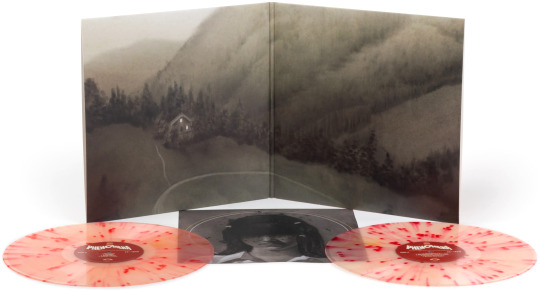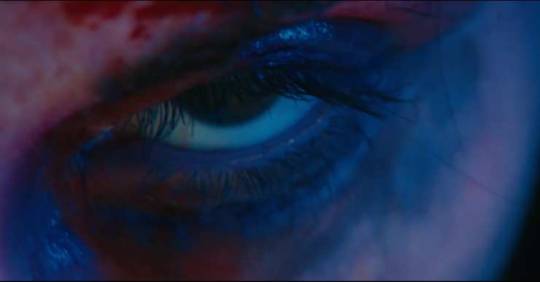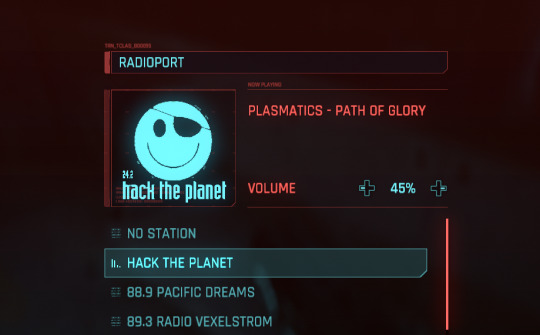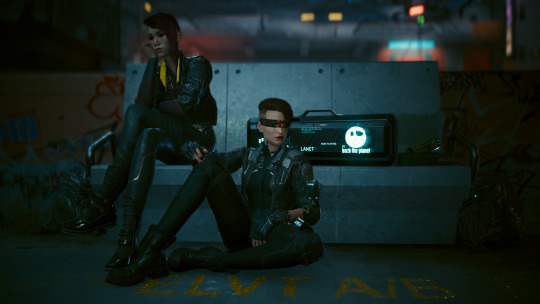#simon boswell
Text

youtube
Good Morning Amerika - Simon Boswell and Iggy Pop - Hardware [Original Soundtrack]
As for the good news: there is no fucking good news! So let's rock, with one of our golden oldies...
#iggy pop#canadian wildfires#simon boswell#new york city#hardware#m.a.r.k. 13#orange glow#smokey haze#Youtube#compare and contrast#1990#2023#cyberpunk#queued
9 notes
·
View notes
Photo




Phenomena's original motion picture soundtrack is available on vinyl via Mondo. It features music by Claudio Simonetti of Goblin (Dawn of the Dead, Deep Red), Simon Boswell (Hackers, Lord of Illusions), and Andi Sex Gang of Sex Gang Children.
Priced at $45, the double-LP album is pressed on 140-gram colored vinyl. It's housed in a gatefold jacket with artwork by Randy Ortiz. Three previously unreleased tracks are included.

#phenomena#dario argento#goblin#claudio simonetti#simon boswell#sex gang children#horror#soundtrack#mondo#vinyl#gift#italian horror#80s horror#1980s horror#jennifer connelly
51 notes
·
View notes
Photo

sound for moving pictures
#movies#music#80s#90s#2000s#john williams#vangelis#howard shore#brad fiedel#michael kamen#john du prez#shirley walker#danny elfman#simon boswell#kristopher carter#don davis#james newton howard#kevin shields#the knife#graham reynolds#nin#chu ishikawa#daft punk#grizzly bear#cd#compact disc#jewel case#superman the movie#blade runner#videodrome
8 notes
·
View notes
Text
2022 FrightFest Halloween Line Up Unveils 'Festive Shockers'
2022 FrightFest Halloween Line Up Unveils 'Festive Shockers'
#frightfesthalloween @FrightFest @CloutComCoUk #horror #TheSoskaSisters
Hallows Eve is nigh which means one thing, FrightFest Halloween! After Glasgow and last month’s frightfully successful August five-day event, Frightfesters end the year with the annual Halloween all dayer. Today we get a look at the line up for bumper all-day Halloween event. All happening on Saturday 29th October, with a six-pack of festive shockers from eroticism to Lovecraftian horrors.
The…

View On WordPress
0 notes
Text
Going Out? Don't miss "The Out" in this week's 2000AD!
In this week's 2000AD, the latest, unsettling chapter of "The Out" by Dan Abnett and Mark Harrison's SF epic lays some scary trails for the weeks to come!
The latest edition of 2000AD, the Galaxy’s Greatest Comic, is out now and on salke in all good comic shops and newsagents, aiming to not only stimulate your imagination circuits but also blow away the January blues.
Prog 2314, featuring a stand out cover from Mark Harrison, includes the latest instalments of “Judge Dredd“, “Proteus Vex“, “Joe Pineapples” and “The Out“, plus the penultimate…

View On WordPress
#2000AD#Annie Parkhouse#Clint Langley#Dan Abnett#downthetubes News#Guy Adams#Jake Lynch#Jim Boswell#Jim Campbell#Jimmy Broxton#Joe Pineapples#Ken Niemand#Mark Harrison#Michael Carroll#Nicolo Assirelli#Pat Mills#Peter Doherty#SF Comics#Simon Bowland#The Out
2 notes
·
View notes
Note
Hi again! Yeah, from your bookshelf! You seem well informed and I wanna know the type of stuff you read and might recommend. I don't even know what to tell you for my interests because I feel like I'm just begining. Sorry I'm young and dumb still haha.
#1 you're not dumb and #2 nothing to apologize for :)
Here's some books I've got on my shelves or that I've read:
Men Who Hate Women: From Incels to Pickup Artists, Laura Bates
Pro: Reclaiming Abortion Rights, Katha Pollitt
Women, Race, & Class, Angela Davis
American Girls, Nancy Jo Sales
Lesbian Culture: An Anthology, eds. Julia Penelope and Susan J Wolf
Lesbian Studies, Margaret Cavendish
Hood Feminism, Mikki Kendall
Against White Feminism, Rafia Zakaria
Sister and Brother: Lesbians and Gay Men Write About Their Lives Together, eds Joan Nestle and John Preston
Another Mother Tongue, Judy Grahn
Aimee & Jaguar, Erica Fischer
Mouths of Rain: An Anthology of Black Lesbian Thought, ed. Briona Simone Jones
Same-Sex Unions in Premodern Europe, John Boswell
The Mary Daly Reader, eds. Jennifer Rycenga and Linda Barufaldi
Hidden from History: Reclaiming the Gay and Lesbian Past, eds. Martin Duberman, Martha Vicinus, George Chauncey Jr.
Testosterone Rex: Myths of Sex, Science, and Society, Cordelia Fine
Speaking Freely: Unlearning the Lies of the Father's Tongue, Julia Penelope
The Resisting Reader, Judith Fetterley
The Double X Economy, Linda Scott
Not That Bad: Dispatches from Rape Culture, ed. Roxane Gay
Home Grown: How Domestic Violence Turns Men Into Terrorists, Joan Smith
Intercourse, Andrea Dworkin
The Trials of Nina McCall: Sex, Surveillance, and the Decades-Long Government Plan to Imprison "Promiscuous" Women, Scott Stern
The Politics of Reality: Essays in Feminist Theory, Marilyn Frye
Only Words, Catharine A. Mackinnon
Everything Below the Waist: Why Health Care Needs a Feminist Revolution, Jennifer Block
Witchcraze: A New History of the European Witch Hunts, Anne Llwellyn Barstow
Cinderella Ate My Daughter: Dispatches from the Frontlines of the New Girlie-Girl Culture, Peggy Orenstein
Invisible Women: Data Bias in a World Designed for Men, Caroline Criado-Perez
Lesbian Ethics: Toward New Values, Sarah Lucia Hoagland
We Were Feminists Once: From Riot Grrrl to CoverGirl, the Buying and Selling of a Political Movement, Andi Zeisler
Of Woman Born: Motherhood as Experience and Institution, Adrienne Rich
On Lies, Secrets, and Silence: Selected Prose, Adrienne Rich
Feminism, Animals, and Science: The Naming of the Shrew, Lynda Birke
The Female Body in Western Culture: Contemporary Perspectives, ed. Susan Rubin Suleiman
Borderlands/La Frontera: The New Mestiza, Gloria Anzaldua
Flesh Wounds: The Culture of Cosmetic Surgery, Virginia L Blum
Black Feminist Thought: Knowledge, Consciousness, and the Politics of Empowerment, Patricia Hill Collins
Pornland: How Porn has Hijacked our Sexuality, Gail Dines
Backlash: The Undeclared War Against American Women, Susan Faludi
From Eve to Dawn: A History of Women in the World, Marilyn French
This Bridge Called My Back: Writings by Radical Women of Color, eds. Cherrie Moraga and Gloria Anzaldua
Seeing Like a Feminist, Nivedita Menon
With Her Machete In Her Hand: Reading Chicana Lesbians, Catriona Reuda Esquibel
The Disappearing L: Erasure of Lesbian Spaces and Culture, Bonnie J. Morris
Foundlings: Lesbian and Gay Historical Emotion before Stonewall, Christopher Nealon
The Persistent Desire: A Butch/Femme Reader, ed. Joan Nestle
The Straight Mind and Other Essays, Monique Wittig
The Trouble Between us: An Uneasy History of White and Black Women in the Feminist Movement, Winifred Breines
Right-Wing Women, Andrea Dworkin
Woman Hating, Andrea Dworkin
Why I Am Not A Feminist, Jessica Crispin
Sapphistries: A Global History of Love Between Women, Leila J Rupp
I tried to avoid too many left turns into my specific interests although if you passionately want to know any of those, I can make you some more lists LOL
I would suggest picking a book that sounds interesting and using the footnotes and bibliography to find more to read. I've done that a lot :) a lot of my books have more sticky tabs or w/e in the bibliography than in the text so I don't lose stuff I'm interested in.
Hope this helps!
30 notes
·
View notes
Text
url song tag
tagged by @smfstump!! thank you whiz <3
i've been listening to a friend's spooky vintage playlist nonstop so i'm making this spooky/autumn themed
B - batman, wolfman, frankenstein or dracula by the diamonds
I - i put a spell on you by nina simone
S - shout sister shout by the boswell sisters
A - autumn leaves by bing crosby
M - my man's an undertaker by dinah washington
W - witchcraft by frank sinatra
I - i'd rather be burned as a witch by eartha kitt
L - love potion no. 9 by the clovers
S - skeleton jangle by old dixieland jazz band
O - old devil moon by ella fitzgerald
N - nightmare by artie shaw
no pressure tagging @logicheartsoul @livingincolorsagain @saryasy @writerkenna @firstelevens
#i was literally walking to work this morning using every bit of self control i had to not scream sing out loud#IT TAKES THE BATMAN WOLFMAN FRANKENSTEIN OR DRACULA#TO PUT HER IN THE MOOD FOR LOVE#IT TAKE THE CATGIRL DOGBOY CREATURE FROM THE BLACK LAGOON#TO MAKE HER FEEL LIKE MAKIN LOVE#it's so catchy#anyways this one was fun!!! making it themed was a fun lil challenge#tag game#tag meme
9 notes
·
View notes
Text



From 50 tracks to 100 in just a few months lmao.
Most of you probably know the story that it started out as a novelty station so I could listen to the soundtracks for Hackers, Johnny Mnemonic, and Strange Days. Then instead of making more stations for other genres I turned HtP in to a variety station with some lore attached to it
here's the partial spotify playlist:
Missing tracks from the spotify playlist:
Lori Carson & Graeme Revell - Fall In The Light
Simon Boswell - One Combination
Strange Fruit - No White Clouds
#yea the Adam and the Ants one was because I really wanted to believe the PL mission was named after that song (it wasn't)#I was really apprehensive about adding K*FDM because of a particular crowd they still attract#Cyberpunk 2077#Cyberpunk 2077 mods#its a very boomer-gen x playlist sorry
3 notes
·
View notes
Text
Book 44: The Map That Changed the World
RNG put me in the 500s, and I kinda forgot to go deeper so I ended up with general science books. There were a ton of all time greats, but I ended up with Simon Winchester's The Map That Changed the World.
This book was about William Smith (1769-1839) a groundbreaking geologist who started out as a surveyor/coal mine manager/canal builder/land drainer. He made the first large-scale geological map in existence. Even after listening to the book twice I'm not entirely sure what the rock he mapped out was, I mean, there are lots of layers of rocks under places, right? I guess it was the type of rock just under the surface of the ground? Anyway, it is considered by many to have birthed the science of geology and kickstarted investigations into the age of the Earth, etc.
William Smith himself had a hard life, his blacksmith father died when he was a child and his mother abandoned him to his cheapskate uncle who Smith had to borrow against his inheritance to get basic reference materials that would further his career as a surveyor. Eventually he ended up in debtors prison after some speculation went wrong and spending on making his extensive geological map. He was prevented from joining the prominent Geological Society by a rival who also made a rival map that stole from Smith's and cut into his sales which landed him in the debtor's prison (Wikipedia disputes this as the rival map came out after Smith landed in jail, but this book shows how anticipation of the rival map cut into his sales, not just when the map finally came out.) Smith's map was championed by our old friend Joseph Banks of the ever-present-in-these-books Royal Society.
Should you read this book: Sure, it's interesting and has lots of good facts about the life of William Smith and life and science in the 1700s-1800s. The author is a bit British, throwing around names like Boswell as if we all know him offhand here in America (I know him, just not offhand).
ART PROJECT: It was kind of impossible to not do the map, and I thought I'd laser burn it then hand color it, but it turns out I don't have the patience to hand color it like William Smith did. So here it is laser burned anyway.

#william smith#joseph banks#royal society#geology#geological map#52books#52booksproject#dewey decimal system#rng
9 notes
·
View notes
Text
A year of enforced historical reading
In January this year, before I knew I had cancer, I decided to set myself the target of reading a book a week. I’ve now read eighty, far exceeding my target - here are some of the historical novels and history-related non-fiction I particularly enjoyed.
History books and history-related non-fiction
Norman Davies, Vanished Kingdoms: The History of Half-Forgotten Europe (2011) My Dad found this hard going; I never wanted it to end; a lesson in the mutability of all political structures.
Roszike Parker, The Subversive Stitch (1984) - a history of embroidery and the different ways it was used to inculcate ideas of femininity.
Sally Smith, Marshall Hall: A Law Unto Himself (2016) – biography of the Edwardian defence barrister, evoking the weird underbelly of his times: a Brighton woman posts out poisoned chocolates; damaged WWI returnees misemploy service revolvers & Hall’s wife dies a gruesome death at the hands of an unqualified abortionist.
Joseph Nash, The Mansions of England in Olden Time (1839-1849) - the detail of these engravings is astounding (Nash worked with Pugin) as is the way he imagines our ancestors frolicking within his expansive, sparsely-decorated interiors.
Tara Hamlin, Decorating the Godly Household (2011) - demonstrates the surprising abundance of early modern domestic religious decoration in Britain despite the iconoclastic tendencies of the period.
John H. Oakley, The Greek Vase: The Art of the Storyteller (2013) - very calming to read. Such beautiful and mysterious things created so long ago in such a different cultural context.
Nicholas Orme, Going to Church in Medieval England (2021) - a great book, wide-ranging in time-period, and giving a good sense of the way church services changed over time, and their complexity compared to later Protestant practice.
Mark Hailwood, Alehouses and Good Fellowship in Early Modern England (2014) - a vision of alehouse culture that was more accepted and socially inclusive than the polemic literature would suggest. The alehouse was not quite a Habermasian public sphere because it was observed and policed; nevertheless it was a place where people debated and exchanged political and religious opinions.
Neil MacGregor, Germany (2016) – very readable account of the material culture, art and architecture of Germany and what they say about how Germans remember their history. Only gripe – something was needed on Germany’s stupendous musical heritage.
Valerie Kivelson, Cartographies of Tsardom (2006) - an academic work, but with a bit of skimming I learned quite a bit about Russian history. Particularly interesting was the way the Russians colonised Siberia from the sixteenth century onwards in a comparable way to the colonisation of the Americas by Britain and Spain, and how they conceptualised Siberia’s forbidding mountains and deserts and nomadic non-Christian peoples as a kind of ‘hell’.
Walter Scott, Tales of a Grandfather (1911, originally 1827) - It gave me a great sense of achievement to get through all 1000+ pages of Scott’s bumper fun book of Scottish history from the Roman invasion to the 18th century – everything he used to write his Scottish novels and a lot more. God they were a violent lot and inventive in their use of it – and to think I may be 2/3 Scottish!
Samuel Johnson & James Boswell, Journey to the Hebrides (1775/1785) - A classic. Johnson attempts to act the antiquarian while Boswell gives you all the gossip on the people they visit and what Johnson said while they were there.
Simon Schama, The Embarrassment of Riches (1988) – the book on 17th century Dutch culture which established Schama’s reputation. Schama has a wonderfully rich vocabulary, although he sometimes overdoes it. Explores some interesting themes, such as the psychological effect of the eternal threat of disaster from the sea. Provides much food for thought into the ways in which Dutch culture paralleled English culture, and the ways in which it differed
Historical fiction
Tobias Smollett, The Expedition of Humphrey Clinker (1771) – a long Rabelaisian epistolatory ramble through 18th century England and Scotland from five people’s perspectives.
Sigrid Undset, Gunnar’s Daughter (1909) – Undset uses her deep knowledge of Norse history and Icelandic saga to tell a woman’s story of revenge in early-Christian Norway.
Elizabeth Jane Howard, The Light Years (1990) and Marking Time (1991) - the Cazalet series. Multiple viewpoints convey the vanished materiality of 1930s/1940s. Superficially light in tone but often dark in subject matter.
Chimamanda Ngozi Adichie, Half of a Yellow Sun (2006) begins hilariously; ends appallingly in its unsparing depiction of the tragedy of Biafra, fictionalising real accounts of civil war.
Maria Edgeworth, Castle Rackrent (1800) – Edgeworth uses stories from real family histories to satirise the Irish Ascendancy. Every student of Irish history should read it.
Walter Scott, Old Mortality (1816) - Scott steeped himself in late-seventeenth century Scottish history to create a fictionalised version of it. He seems to be saying that extremists of all types are as bad as each other, as are those who look to take advantage of religious and political divisions for personal gain. There are memorable descriptions of battles won and lost and all ends spectacularly with a confrontation on a waterfall and a Hamlet-style multiple body count. He does however play fast and loose with historical fact, weaving in memorable incidents from other contexts in order to sensationalise his narrative.
Jean Giono, The Horseman on the Roof (1951) – a mesmerising and lyrical story set in the midst of a cholera epidemic in southern France in the early nineteenth century, with an impossibly romantic hero, Angelo. With its descriptions of birds attacking the dead and the living, could it have inspired Hitchcock’s The Birds?
Eliza Haywood, The Female Spectator, ed. Gabrielle M. Firmager (1993) - a selection from The Female Spectator, published in the mid 1740s. Although Eliza Haywood claims a moralistic purpose this is a world in which misbehaviour (usually sexual) is lying just below the pristine surface of society, and never far from people’s thoughts.
6 notes
·
View notes
Text
Sickle Cell and the Prison Industrial Complex
This article was authored by Professor Simon Dyson (Sickle Cell and the Social Sciences) and Professor Gwyneth Boswell of the University of East Anglia in Norwich, England. It was published in The Howard Journal of Crime and Justice in 2006. Together, Dyson and Boswell highlight seventeen cases between US and UK prisons. Seven of these cases demonstrate that the care of incarcerated people with sickle cell anemia "falls well short of the minimum standards that might reasonably be required." Ten of them involved forced restraints of Warriors resulting in their deaths. To add insult to injury, the people who the criminal injustice system enlists to speak on its behalf oftentimes conflate sickle cell anemia with sickle cell trait, which is the genetic carrier state in which the person who has it is usually healthy. But, as you will read in the article, trait has been weaponized by the carceral state to reinforce preexisting racial discrimination in employment, insurance, and other spheres. And as was written in The New York Times last year, American police when they can will use trait as an alibi for why a Black person happened to die in their custody.
Attached below is a table listing the seventeen cases I mentioned above. Below that is The New York Times article.
#sickle cell awareness#sicklecellwarrior#sickle cell disease#sickle cell anemia#prison abolition#prison industrial complex#prison system#us race relations#american race relations#antiblackness#antiblackracism#social justice#racial justice#racial prejudice#racial abuse#human rights#carceral state#police brutality#police murder
10 notes
·
View notes
Text

Spectacle Radio ep.100 :: 05.11.23 :: It's horrible, I love it, what is it?
Slava Tsukerman - Liquid Sky (1982)
Main Titles from Quartier Mozart (Jean-Pierre Bekolo, 1992)
Tokyo Kid Brothers - I kind of hate my father (Throw Away Your Books, Rally in the Streets // Shuji Terayama, 1971)
De Kalafe e a Turma - Guerra (Awakening of the Beast // Joes Moijica Marins, 1970)
Stelvio Cipriani - Week-end with Mary (Femina Ridens // Piero Schivazappa, 1969)
Nicola Piovani - Main Titles from Footprints on the Moon (Luigi Bazzoni, 1975)
-
Michael Nyman - Squaline Fallaize (The Falls // Peter Greenaway, 1980)
Zdeněk Liška - The Deadly Invention (Karel Zeman, 1958)
Andrzej Korsynski - Main Titles from The Devil (Andrzej Zulawski, 1972)
Vangelis - Entends Tu Les Chiens Aboyer (Do You Hear the Dogs Barking? // François Reichenbach, 1975)
Stelvio Cipriani - La Polizia Chiede Aiuto #4 (Massimo Dallamano, 1974)
Rheingold - FanFanFanatisch (Der Fan // Eckhart Schmidt, 1982)
Þeyr - Rúdólf (Rokk Í Reykjavík, 1982)
Jean-Michel Jarre - Zoolook (Remix) (Magic of the Universe // Tata Esteban, 1986)
Westernhagen - Celebration (Supermarkt // Roland Klick, 1974)
J.A. Seazer - Buddha Child (Pastoral: To Die in the Country // Shuji Terayama, 1974)
Toru Takemitsu - End Titles from The Ruined Map (Hiroshi Teshigahara, 1968)
Michael Nyman - Castral Fallvernon (The Falls // Peter Greenaway, 1980)
-
Phil Oakley & Giorgio Moroder // Together In Electric Dreams (from Electric Dreams, 1984)
Rheingold // Fan Fan Fantatisch (from Der Fan, 1982)
Hiroyuki Onogawa // from August In the Water (1995)
Chuck Cirino // from Chopping Mall (1986)
Yuji Koseki // from Mothra (1961)
Shintaro Katsu // Otento-san (theme from Tale of Zatoichi, 1962)
music from Out 1 (1971)
Hussein al-Iman // music from Anyab (1981)
Anna Karina // Roller Girl (from Anna, 1967)
Fabio Frizzi & Cricket // You Are Not the Same (from Contraband, 1980)
Stardust Brothers // Crazy Game (from Legend of the Stardust Brothers, 1985)
BED: theme from 300 (2006) slowed down x3
-
Simon Boswell - It’s Horrible, I Love it, What Is It? (Hardware, 1990)
Method Man - Release Yo Self (Prodigy remix) (One Eight Seven, 1997)
Shriekback - The Big Hush (Manhunter, 1986)
Tangerine Dream - Teetering Scales (Miracle Mile, 1988)
Sue Saad - Looker (Looker, 1981)
Sheryl Lee Ralph feat. Cedella Marley & Sharon Marley Prendergast - The Mighty Quinn (The Mighty Quinn, 1989)
3 notes
·
View notes
Text
Synapse Films Unleashes PHENOMENA in 4K Ultra HD!
Horror Master Dario Argento’s PHENOMENA – the ‘80s Supernatural Creepy Horror Classic – arrives on 4K UHD loaded with Bonus Features.

On March 14th, Synapse Films unleashes Phenomena on UHD, including all three versions of the film newly restored in 4K with Dolby Vision.
Jennifer Corvino (Oscar winner Jennifer Connelly) is sent to a Swiss boarding school by her famous actor father. The sleepwalking teen – who also is a telekinetic with the power to commune with bugs – embroils herself in a series of vicious murders. Jennifer begins to unravel the mystery of the killings with the help of an entomologist, Dr. McGregor (Donald Pleasence) and his chimpanzee Inga. The soundtrack features music from Goblin, Motörhead, Iron Maiden, Andi Sex Gang, Bill Wyman and Simon Boswell. Phenomena is Dario Argento at his very hypnotic and nightmarish best.
The two-disc set includes the original Italian version (116 mins), the International cut (110 mins), and the U.S. “Creepers” cut (83 mins), featuring multiple audio/language options (with subtitles) in Lossless DTS-HD Master Audio.
Special features include two commentary tracks, one by film historian Troy Howarth on the Italian version, the other by Argento scholar Derek Botelho and film historian David Del Valle on the International version; Of Flies and Maggots – a feature-length documentary about the making of the film; a visual essay by Michael Mackenzie comparing the different cuts of Phenomena; Jennifer music video – directed by Argento; theatrical trailers; radio spots; slipcover artwork from Nick Charge; and a reversible cover with the original Italian Phenomena art.
youtube
#blu-ray news#4k uhd#phenomena#dario argento#synapse films#jennifer connelly#horror#supernatural#witches
3 notes
·
View notes
Link
Sex Gang Children perform their jagged art-rock live at the Lexington, London. March 4th. See you there!
2 notes
·
View notes
Text
Philip's CD-i "Burn Cycle" commercial from 1994 - AI Enhanced
Released in 1994, "Burn:Cycle" is one of the most notable titles for the Philips CD-i, a platform that struggled to carve out a niche in the competitive gaming market of the 90s. "Burn:Cycle" is often remembered for its ambitious blend of live-action video sequences, puzzle-solving gameplay, and a cyberpunk narrative that explored themes of consciousness and identity. It was one of the first games to be explicitly marketed as an interactive movie, and it sought to leverage the CD-i's multimedia capabilities to deliver a cinematic gaming experience.
Graphics and Audio
"Burn:Cycle" featured a mix of pre-rendered 3D backgrounds and full-motion video (FMV), a technique that was quite cutting-edge at the time. The pre-rendered scenes provided a visually immersive environment that was richer and more detailed than what most contemporary systems could handle. These graphics helped to establish a convincing cyberpunk world, complete with neon-lit cityscapes and gritty interiors that effectively conveyed the game's dystopian setting.
The integration of FMV into the gameplay was one of the game's major selling points. "Burn:Cycle" used live-action video not just for cutscenes but as an integral part of the gameplay, which was still a novelty. The video quality, by today's standards, might seem grainy and low-resolution, but at the time, it was a significant leap forward in terms of creating an immersive narrative experience in games.
The audio landscape of "Burn:Cycle" is particularly noteworthy. The soundtrack, composed by Simon Boswell, is a blend of electronic and orchestral music that fits perfectly with the game’s futuristic tone. The voice acting and sound effects are generally well-executed, enhancing the overall atmospheric tension and helping to drive the narrative forward.
Gameplay Mechanics
The gameplay of "Burn:Cycle" is primarily focused on puzzle-solving and narrative choices, with some light action elements. Players take on the role of Sol Cutter, a data thief who must navigate through a series of cybernetic puzzles and interactions with other characters to cure himself of a deadly virus that threatens to end his life within two hours—real-time ticking down that adds a sense of urgency to the player's actions.
The interface for interacting with the digital world of "Burn:Cycle" was innovative for its time, utilizing a point-and-click mechanism that allowed players to hack into computer systems, manipulate objects, and make narrative-affecting decisions. This gameplay mechanic anticipated the later popularity of narrative-driven adventure games.
Acting and Narrative
The acting in "Burn:Cycle" is a mixed bag, typical of early FMV games where performance quality varied widely. The lead performance by Vivi Devereaux as Sol Cutter is generally strong, helping to ground the high-concept story with a sense of personality and urgency. However, some secondary performances come off as stiff or over-the-top, reflecting the experimental nature of live-action recording in video games during the early '90s.
The narrative is where "Burn:Cycle" really tries to set itself apart, featuring a complex cyberpunk story that delves into themes of technology, identity, and reality. The story is engaging and well-crafted, with multiple layers of conspiracy and philosophical questioning that are rare for video games of that era.
Innovations and Influence
"Burn:Cycle" was ahead of its time in many ways. Its use of FMV to drive gameplay, not just narrative, was relatively innovative, as was its integration of a real-time countdown mechanic that added urgency to the player's decisions. The game's attempt to blend cinematic storytelling with interactive gameplay elements anticipated the future of video gaming and can be seen as a precursor to later narrative-driven games.
Conclusion
"Burn:Cycle" remains one of the more memorable titles for the Philips CD-i, notable both for its ambitious use of technology and its effort to push the boundaries of narrative in video games. While it may not have been a commercial blockbuster, its innovative approach to game design and storytelling has earned it a cult status among retro gaming enthusiasts. For those interested in the evolution of interactive cinema and narrative-heavy games, "Burn:Cycle" is a fascinating study in early multimedia gaming.
0 notes
Text
~Above the Cut~Len Boswell
The book Barnum’s Angel was a mixture of history, fiction, and fantasy. I would say that he delivered more than I expected, and I am looking forward to reading book two in the Pale Chronicles. I hope to see more in this Chronicle.
=ap_rdr&store_ref=ap_rdr&isDramIntegrated=true&shoppingPortalEnabled=true&fbclid=IwAR1lzI55LrXW5mxjbv_0BaL
It varies a bit by book. Each book in my Simon Grave…

View On WordPress
0 notes